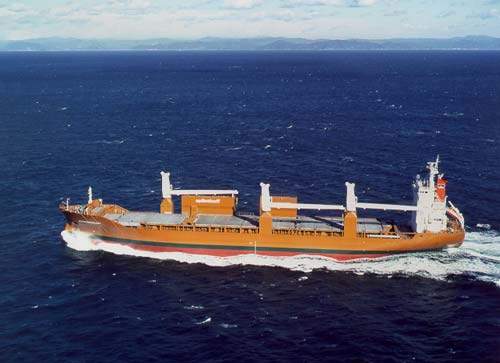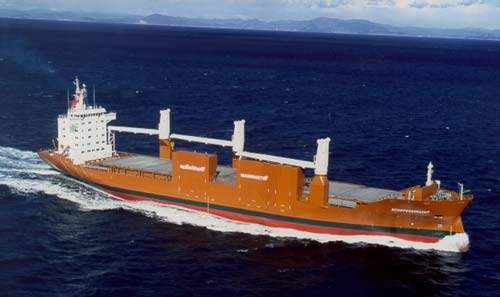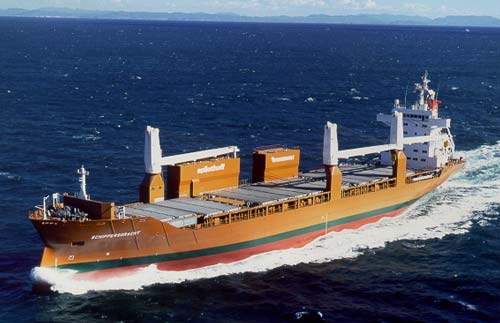The 21,402dwt tweendecker Schippersgracht was the first in a series of ten multipurpose vessels ordered by Amsterdam-based Spliethoff’s Bevrachtingskantoor. Six were ordered from the Japanese shipyards Mitsubishi Heavy Industries and Tsuneishi Shipbuilding. A further four were ordered from Stocznia Szczecinska in Poland. The 21,402dwt Schippersgracht was built at Mitsubishi’s Shimonoseki yard.
The vessel was delivered in 2000 and is deployed primarily in the shipment of paper from the Baltic to North America for Finnish forestry group UPM-Kymmene. It made her first call at the Port of Baltimore.
The vessel is classed by Lloyd’s Register and flies the Netherlands flag.
Design
The trading operations planned for the Schippersgracht were important considerations in her design. The vessel has a hull reinforced to Lloyd’s Register ice-class 1A requirements, due to its Baltic deployment, and meets UPM-Kymmene’s capacity, service speed, fast loading and discharging requirements.
Schippersgracht can carry 1,100 TEU, but has been designed with the flexibility to accept a wide range of dry cargoes. The vessel has three cargo holds, with access through wide hatch openings. Flexibility is derived from the height adjustable and removable tweedeck.
The vessel has five sideloaders with a payload capacity of 16t, which enable weather-protected handling of sensitive products such as paper. Paper is an important component of Schippersgracht’s trade. The sideloaders enable the transfer of cargo between the quay and the hold bottom, as well as intermediate tweendeck levels, and enable full use of the cargo holds.
The weatherdeck and removeable tweendeck hatchcovers were supplied by MacGregor-Kayaba. The tweendeck covers, constituted of a total of 16 panels, can be locked into position at three levels or deployed as portable grain bulkheads. The deck cranes handle the hatchcovers.
The container-handling capacity provides for roughly 40% below-deck stowage, with the remaining 60% carried on the weatherdeck. The vessel has slots for 120 reefer containers.
Schippersgracht is equipped with three cranes. One is positioned forward on the starboard side, while the other two are mounted laterally on the port side. The jib cranes have a capacity of up to 120t within a radius of 14m. The cranes are mounted on high pedestals, due to the planned use of the weatherdeck for carrying containers and timber.
The vessel has an overall length of 168.21m and a moulded breadth of 25.2m. Its gross tonnage is 16,641t and has a deadweight of 18,900t.
Propulsion
The vessel is powered by a six-cylinder Wärtsilä 64 engine giving an output of 12,060kW. Power is transmitted from the engine via an elastic coupling through a reduction gear to a controllable pitch propeller.
The engine is designed to make optimum use of space by locating the lubricating oil and cooling water pumps, oil cooler and filter on the Wärtsil 64. The new design meets IMO emissions limits, but the cylinder heads of the Wärtsil 64 have also been prepared for a possible retrofit of the direct water injection method of achieving further reductions in nitrogen oxide emission.
The recorded value for nitrogen oxide emissions for the first seagoing installation of the Wärtsilä 64, installed on the shortsea containership named Containerships VI, was 12.4g/kWh – well within the IMO set ceiling of 14.8g/kWh.
The vessel has a service speed of 19.5 knots and a draught of 10.71m.










